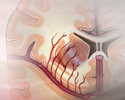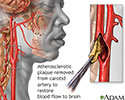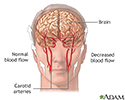Transient ischemic attack
Mini stroke; TIA; Little stroke; Cerebrovascular disease - TIA; Carotid artery - TIA
A transient ischemic attack (TIA) occurs when blood flow to a part of the brain stops for a brief time. A person will have stroke-like symptoms for up to 24 hours. In most cases, the symptoms last for 1 to 2 hours.
A transient ischemic attack is a warning sign that a true stroke may happen in the future if something is not done to prevent it.
Causes
A TIA is different than a stroke. After a TIA, the blockage breaks up quickly and dissolves on its own. A TIA does not cause brain tissue to die.
The loss of blood flow to an area of the brain can be caused by:
- A blood clot in an artery of the brain
- A blood clot that travels to the brain from somewhere else in the body (for example, from the heart)
- An injury to blood vessels
- Narrowing of a blood vessel in the brain or leading to the brain
High blood pressure is the main risk for TIAs and stroke. Other major risk factors are:
- Irregular heartbeat called atrial fibrillation
- Diabetes
- Family history of stroke
- Being male
- High cholesterol
- Tendency to have abnormal blood clotting
- Increasing age, especially after age 55
- Ethnicity (African Americans are more likely to die of stroke)
- Smoking
- Alcohol use
- Recreational drug use
- History of prior TIA or stroke
People who have heart disease or poor blood flow in their legs caused by narrowed arteries are also more likely to have a TIA or stroke.
Symptoms
Symptoms begin suddenly, last a short time (from a few minutes to 1 to 2 hours), and go away. They may occur again at a later time.
The symptoms of TIA are the same as the symptoms of a stroke, and include:
- Change in alertness (including sleepiness or unconsciousness)
- Changes in the senses (such as hearing, vision, taste, and touch)
- Mental changes (such as confusion, memory loss, difficulty writing or reading, trouble speaking or understanding others)
- Muscle problems (such as weakness, trouble swallowing, trouble walking)
- Dizziness or loss of balance and coordination
- Lack of control over the bladder or bowels
- Nerve problems (such as numbness or tingling on one side of the body)
Exams and Tests
Often, the symptoms and signs of a TIA will have gone away by the time you get to the hospital. A TIA diagnosis may be made based on your medical history alone.
The health care provider will do a complete physical exam to check for heart and blood vessel problems. You will also be checked for nerve and muscle problems.
The doctor will use a stethoscope to listen to your heart and arteries. An abnormal sound called a bruit may be heard when listening to the carotid artery in the neck or other artery. A bruit is caused by irregular blood flow.
Tests will be done to rule out a stroke or other disorders that may cause the symptoms:
- You will likely have a head CT scan or brain MRI. A stroke may show changes on these tests, but TIAs will not.
- You may have an angiogram, CT angiogram, or MR angiogram to see which blood vessel is blocked or bleeding.
- You may have an echocardiogram if your doctor thinks you may have a blood clot from the heart.
- Carotid duplex (ultrasound) can show if the carotid arteries in your neck have narrowed.
- You may have an electrocardiogram (ECG) and heart rhythm monitoring tests to check for an irregular heartbeat.
Your doctor may do other tests to check for high blood pressure, heart disease including an irregular heartbeat, diabetes, high cholesterol, and other causes of, and risk factors for TIAs or stroke. You may have an EEG test to make sure your symptoms are not due to a seizure.
Treatment
If you have had a TIA within the last 48 hours, you will likely be admitted to the hospital so that doctors can search for the cause and monitor you.
High blood pressure, heart disease, diabetes, high cholesterol, and blood disorders will be treated as needed. You will be encouraged to make lifestyle changes to reduce your risk of further symptoms. Changes include quitting smoking, exercising more, and eating healthier foods.
You may receive blood thinners, such as aspirin, heparin, warfarin (Coumadin), or direct acting oral anticoagulants (DOACs) to reduce blood clotting. Some people who have blocked neck arteries may need surgery (carotid endarterectomy). If you have an irregular heartbeat (atrial fibrillation), you will be treated to avoid future complications.
Outlook (Prognosis)
TIAs do not cause lasting damage to the brain.
But, TIAs are a warning sign that you may have a true stroke in the coming days or months. Some people who have a TIA will have a stroke within 3 months. Half of these strokes happen during the 48 hours after a TIA. The stroke may occur that same day or at a later time. Some people have only a single TIA, and others have more than one TIA.
You can reduce your chances of a future stroke by following up with your provider to manage your risk factors.
When to Contact a Medical Professional
A TIA is a medical emergency. Call 911 or the local emergency number right away. Do not ignore symptoms just because they go away. They may be a warning of a future stroke.
Prevention
Follow your provider's instructions on how to prevent TIAs and strokes. You will likely be told to make lifestyle changes and take medicines to treat high blood pressure or high cholesterol.
References
Biller J, Ruland S, Schneck MJ. Ischemic cerebrovascular disease. In Jankovic J, Mazziotta JC, Pomeroy SL, Newman NJ, eds. Bradley and Daroff's Neurology in Clinical Practice. Philadelphia, PA: Elsevier; 2022:chap 65.
Gladstone DJ, Lindsay MP, Douketis J, et al. Canadian stroke consortium. Canadian stroke best practice recommendations: secondary prevention of stroke Update 2020. Can J Neurol Sci. 2022;49(3):315-337. PMID: 34140063 pubmed.ncbi.nlm.nih.gov/34140063/.
Grundy SM, Stone NJ, Bailey AL, et al. 2018 AHA/ACC/AACVPR/AAPA/ABC/ACPM/ADA/AGS/APhA/ASPC/NLA/PCNA Guideline on the management of blood cholesterol: executive summary: a report of the American College of Cardiology/American Heart Association Task Force on Clinical Practice Guidelines. J Am Coll Cardiol. 2019;73(24):3234-3237. PMID: 30423391 pubmed.ncbi.nlm.nih.gov/30423391/.
January CT, Wann LS, Calkins H, et al. 2019 AHA/ACC/HRS focused updated of the 2014 AHA/ACC/HRS guideline for the management of patients with atrial fibrillation: a report of the American College of Cardiology/American Heart Association Task Force on practice guidelines and the Heart Rhythm Society. J Am Coll Cardiol. 2019;74(1):104-132. PMID: 30703431 pubmed.ncbi.nlm.nih.gov/30703431/.
Kernan WN, Ovbiagele B, Black HR, et al. Guidelines for the prevention of stroke in patients with stroke and transient ischemic attack: a guideline for healthcare professionals from the American Heart Association/American Stroke Association. Stroke. 2014;45(7):2160-2236. PMID: 24788967 pubmed.ncbi.nlm.nih.gov/24788967/.
Kleindorfer DO, Towfighi A, Chaturvedi S, et al. 2021 Guideline for the prevention of stroke in patients with stroke and transient ischemic attack: a guideline from the American Heart Association/American Stroke Association. Stroke. 2021;52(7):e364-e467. PMID: 34024117 pubmed.ncbi.nlm.nih.gov/34024117/.
Meschia JF, Bushnell C, Boden-Albala B, et al. Guidelines for the primary prevention of stroke: a statement for healthcare professionals from the American Heart Association/American Stroke Association. Stroke. 2014;45(12):3754-3832. PMID: 25355838 pubmed.ncbi.nlm.nih.gov/25355838/.
Papa L, Meurer WJ. Stroke. In: Walls RM, ed. Rosen's Emergency Medicine: Concepts and Clinical Practice. 10th ed. Philadelphia, PA: Elsevier; 2023:chap 87.
Riegel B, Moser DK, Buck HG, et al; American Heart Association Council on Cardiovascular and Stroke Nursing; Council on Peripheral Vascular Disease; and Council on Quality of Care and Outcomes Research. Self-care for the prevention and management of cardiovascular disease and stroke: a scientific statement for healthcare professionals from the American Heart Association. J Am Heart Assoc. 2017;6(9):e006997. PMID: 28860232 pubmed.ncbi.nlm.nih.gov/28860232/.
Whelton PK, Carey RM, Aronow WS, et al. 2017 ACC/AHA/AAPA/ABC/ACPM/AGS/APhA/ASH/ASPC/NMA/PCNA Guideline for the prevention, detection, evaluation, and management of high blood pressure in adults: a report of the American College of Cardiology/American Heart Association Task Force on Clinical Practice Guidelines. J Am Coll Cardiol. 2018;72(3):e127-e248. PMID: 29133354 pubmed.ncbi.nlm.nih.gov/29133354/.
Stroke
Animation
Endarterectomy - illustration
Endarterectomy
illustration
Transient Ischemic attack (TIA) - illustration
Transient Ischemic attack (TIA)
illustration
Review Date: 4/25/2022
Reviewed By: Joseph V. Campellone, MD, Department of Neurology, Cooper University Hospital, Camden, NJ. Review provided by VeriMed Healthcare Network. Also reviewed by David C. Dugdale, MD, Medical Director, Brenda Conaway, Editorial Director, and the A.D.A.M. Editorial team.


















